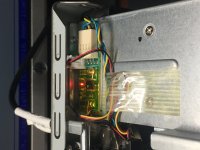Alex Quiniou
Cadet
- Joined
- May 13, 2021
- Messages
- 3
Hi
I have made a fresh install of Truenas 12.0 u3 on my Qnap TS251+ (8G) and the fan are spinning always at 100%.

 www.qnap.com
The cpu is Intel(R) Celeron(R) CPU J1900 @ 1.99GHz
www.qnap.com
The cpu is Intel(R) Celeron(R) CPU J1900 @ 1.99GHz
https://ark.intel.com/content/www/u...-processor-j1900-2m-cache-up-to-2-42-ghz.html
My cpu oscillates between 39 ° and 43 ° which is very good. My CPU usage is very low (0-20%).
When QnapOS was still in place it changed the speed of the fan dynamically.
The option in the bios to manage the power for the fan curve is checked too.
Is there something I can do ?
---
I had posted this on Jira and William Grzybowski recommended to post on the forum to get help
I have search for solution here :
But if you have any info please share
I have made a fresh install of Truenas 12.0 u3 on my Qnap TS251+ (8G) and the fan are spinning always at 100%.

TS-251+ | Hardware Specs
QNAP designs and delivers high-quality network attached storage (NAS) and professional network video recorder (NVR) solutions to users from home, SOHO to small, medium businesses.
https://ark.intel.com/content/www/u...-processor-j1900-2m-cache-up-to-2-42-ghz.html
My cpu oscillates between 39 ° and 43 ° which is very good. My CPU usage is very low (0-20%).
When QnapOS was still in place it changed the speed of the fan dynamically.
The option in the bios to manage the power for the fan curve is checked too.
Is there something I can do ?
---
I had posted this on Jira and William Grzybowski recommended to post on the forum to get help
I have search for solution here :
- https://www.truenas.com/community/threads/high-fan-speed.22223/
- https://www.truenas.com/community/threads/fan-speed-problem.50075/
- https://www.truenas.com/community/threads/control-of-fan-speeds-from-freenas.16486/
- https://www.truenas.com/community/threads/setting-fan-speed-on-hb-1235.68308/
- https://www.truenas.com/community/threads/fan-speed-issue.43328/
- https://www.truenas.com/community/threads/cpu-fan-speed-stuck.50958/
But if you have any info please share



